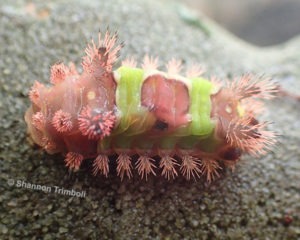I almost had a really bad experience on Sunday. The baby ducks aren’t babies any more. They have learned to fly and while we’ve caught the drakes and trimmed their flight feathers, we haven’t been able to catch the hens yet. They are too fast and can fly too well.
Saturday, a couple of hens decided to perch on the edge of a birdbath that I have planted with sedum. Of course, they both tried perching on the same side which caused the top of the birdbath to flip off the base. The hens were spooked and flew up to the roof of the house, but were unharmed. After a few minutes, they were back down on the ground slowly stalking the upside down birdbath and looking at it like they were trying to figure out what had just happened.
I had to get to the farmer’s market and sedum is practically indestructible, so I left it lying upside down in the grass. Sunday morning I went out to replant my sedum after the rain stopped. I flipped the concrete birdbath over and saw this little guy crawling around the rim, only inches from where I had just put my fingers. I was very happy that I hadn’t accidentally touched him when I flipped over the birdbath.

This is a saddleback caterpillar (Acharia stimulea). The saddleback caterpillar is a native caterpillar. It gets its name from the markings on its back. The bright green patch is supposed to be reminiscent of a saddle blanket while the darker marking in the middle is said to be the saddle.
Although I think saddleback caterpillars are pretty, they aren’t a caterpillar that you want to mess with. Even lightly brushing up against one of these caterpillars can cause the spines to break off in your skin. The spines contain a venom that can cause a painful burning sensation. Some people describe it as being similar to a bad bee sting. Depending on how sensitive you are to the venom, in addition to the pain and burning it can also cause swelling or more serious symptoms including anaphylactic shock in worst case scenarios.
Saddleback caterpillars eat the leaves of a wide variety of different plants including maples, spicebush, sunflowers, dogwoods, gladiolas, crape myrtle, and many others. (My birdbath sits under a maple tree, so I’m guessing that’s where my saddleback caterpillar came from.) They have modified suckers on the bottoms of their feet that allow them to cling to almost any surface. They are often found clinging to the bottom of leaves.
The saddleback caterpillar turns into a moth that is often referred to as the saddleback caterpillar moth. The saddleback caterpillar moth is in the Limacodidae family, also known as the slug caterpillar moths, because many of the caterpillars in this family are said to look like slugs when they move.
Saddleback caterpillar moths aren’t nearly as interesting looking as the caterpillars. Like many moths, they don’t eat as adults and thus don’t live very long after they complete metamorphosis. Their whole purpose after they turn into moths is to mate and lay eggs.
Although this species isn’t a pollinator, it is an important species to know if you are interested in gardening or plants that pollinators use. The wide variety of native and non-native plants the saddleback caterpillar feeds on means that anyone who enjoys gardening or looking at plants in the woods or fields may encounter this little creature.
With as much time as I spend in the woods and my dislike of wearing gloves when gardening, I’m honestly surprised that I have never had a bad encounter with a saddleback caterpillar. Sunday was probably the closest I’ve ever come, at least that I know about. I’m just glad that Sunday wasn’t the day that my luck ran out. But since it wasn’t, I was happy to get to see the little guy because they are pretty and I rarely find them.

This article was part of Shannon’s original Kentucky Pollinators and Backyard Wildlife blog which evolved into the blog for Backyard Ecology.

Backyard Ecology: Exploring Nature in Your Backyard
Nature isn’t just “out there.” It’s all around us, including right outside our doors. Hi, my name is Shannon Trimboli, and I am the host of Backyard Ecology. I live in southcentral Kentucky and am a wildlife biologist, educator, author, beekeeper, and owner of a nursery specializing in plants for pollinators and wildlife conservation. I invite you to join me as we ignite our curiosity and natural wonder, explore our yards and communities, and improve our local pollinator and wildlife habitat. Learn more or subscribe to my email list at www.backyardecology.net.

Leave a Reply